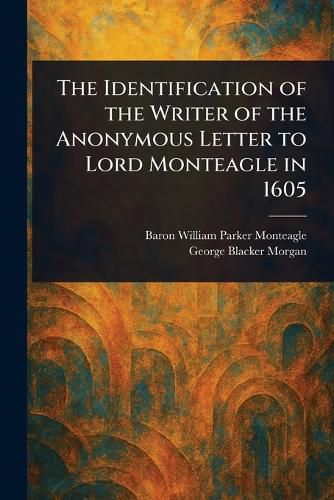Readings Newsletter
Become a Readings Member to make your shopping experience even easier.
Sign in or sign up for free!
You’re not far away from qualifying for FREE standard shipping within Australia
You’ve qualified for FREE standard shipping within Australia
The cart is loading…






This title is printed to order. This book may have been self-published. If so, we cannot guarantee the quality of the content. In the main most books will have gone through the editing process however some may not. We therefore suggest that you be aware of this before ordering this book. If in doubt check either the author or publisher’s details as we are unable to accept any returns unless they are faulty. Please contact us if you have any questions.
Unravel the mysteries surrounding the infamous Gunpowder Plot of 1605 with "The Identification of the Writer of the Anonymous Letter to Lord Mounteagle in 1605." This historical text delves into the crucial role of the anonymous letter delivered to Lord Mounteagle, a key piece of evidence in uncovering the plot to assassinate King James I.
Explore the intricate web of intrigue and suspicion as William Parker, Francis Tresham, and William Vavasour dissect the evidence in their quest to identify the letter's author. Was it Francis Tresham himself, attempting a last-minute act of conscience, or was another conspirator attempting to sabotage the plan?
Journey back to 17th-century England and examine the details of this pivotal moment in history. This republication offers a fascinating glimpse into one of history's most audacious conspiracies and the efforts to expose it. A must-read for those interested in British history, the Renaissance, and true crime.
This work has been selected by scholars as being culturally important, and is part of the knowledge base of civilization as we know it.
This work is in the public domain in the United States of America, and possibly other nations. Within the United States, you may freely copy and distribute this work, as no entity (individual or corporate) has a copyright on the body of the work.
Scholars believe, and we concur, that this work is important enough to be preserved, reproduced, and made generally available to the public. We appreciate your support of the preservation process, and thank you for being an important part of keeping this knowledge alive and relevant.
$9.00 standard shipping within Australia
FREE standard shipping within Australia for orders over $100.00
Express & International shipping calculated at checkout
Stock availability can be subject to change without notice. We recommend calling the shop or contacting our online team to check availability of low stock items. Please see our Shopping Online page for more details.
This title is printed to order. This book may have been self-published. If so, we cannot guarantee the quality of the content. In the main most books will have gone through the editing process however some may not. We therefore suggest that you be aware of this before ordering this book. If in doubt check either the author or publisher’s details as we are unable to accept any returns unless they are faulty. Please contact us if you have any questions.
Unravel the mysteries surrounding the infamous Gunpowder Plot of 1605 with "The Identification of the Writer of the Anonymous Letter to Lord Mounteagle in 1605." This historical text delves into the crucial role of the anonymous letter delivered to Lord Mounteagle, a key piece of evidence in uncovering the plot to assassinate King James I.
Explore the intricate web of intrigue and suspicion as William Parker, Francis Tresham, and William Vavasour dissect the evidence in their quest to identify the letter's author. Was it Francis Tresham himself, attempting a last-minute act of conscience, or was another conspirator attempting to sabotage the plan?
Journey back to 17th-century England and examine the details of this pivotal moment in history. This republication offers a fascinating glimpse into one of history's most audacious conspiracies and the efforts to expose it. A must-read for those interested in British history, the Renaissance, and true crime.
This work has been selected by scholars as being culturally important, and is part of the knowledge base of civilization as we know it.
This work is in the public domain in the United States of America, and possibly other nations. Within the United States, you may freely copy and distribute this work, as no entity (individual or corporate) has a copyright on the body of the work.
Scholars believe, and we concur, that this work is important enough to be preserved, reproduced, and made generally available to the public. We appreciate your support of the preservation process, and thank you for being an important part of keeping this knowledge alive and relevant.